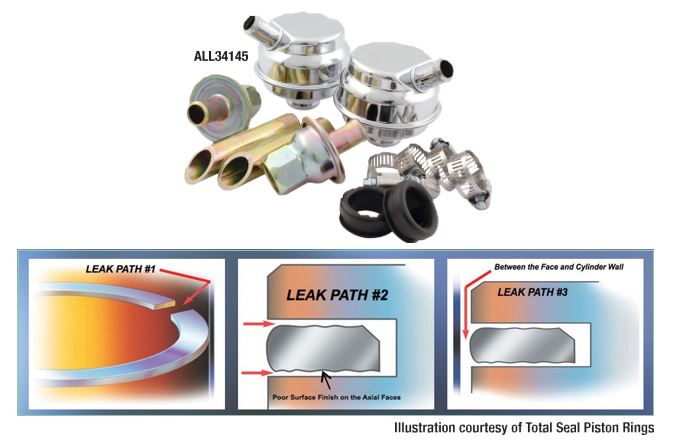The term blow-by certainly isn’t viewed in a positive light, yet each and every internal combustion engine, regardless of brand, builder, or budget, is subjected to it. Blow-by, also referred to as crankcase pressure, occurs during the combustion process when burned gases leak past the piston rings and into the crankcase. The rotation and speed of the rotating assembly, which also causes windage, contributes to crankcase pressure, as well.
Crankcase pressure is released through the breathers, even to the extent of causing them to drip or blow oil. In a worst-case scenario where problematic piston, ring, or cylinder conditions may exist, the pressure can actually overcome what the breathers can handle and cause gaskets to blow-out and begin leaking.
Even in a perfect world, precisely machined pistons and rings fit to perfectly round and true cylinders would still result in a minute amount of blow-by, solely due to the necessary side (axial), back, and end gap clearance. Clearance must not only exist in the rear and sides so that the rings remain free to turn within the ring lands, but also at the end gaps so that the ring ends do not butt together.
This is the primary reason that it is difficult to eliminate blow-by – simply put, there are three leak paths for the combustion gases to follow. Not only can these gases leak between the top compression ring’s end gap and between the cylinder and face of the rings, but they can also leak between the back of the rings and ring lands. These facts illustrate the critical function and importance of the top compression ring: to simply and effectively seal combustion pressure. It’s important to note that although the second ring is also referred to as a compression ring, it’s function is solely as a scraper, preventing excess oil from reaching the top ring, and thereby compromising its sealing ability.
Another crucial factor is piston ring end gap. End gap is set so that when the engine is up and running at normal operating temperatures, the gap should theoretically become negligible, yet sufficient to prevent the ends from butting together. If at any time the ring ends have butted together, they will have a shiny appearance that is evident during tear down. Extreme cases of end gap butting can cause the rings to bind in the cylinders, damaging the rings, pistons, and cylinder bores. Similar binding conditions can occur if the rings have insufficient side or back clearance.

While excessive blow-by can be caused by pistons and rings that are simply worn-out or were improperly prepped during a prior rebuild, detonation, overheating or a lack of lubrication can be culprits as well, quickly destroying an otherwise perfectly good set of components. After literally millions of cycles, pistons, rings, and the cylinders gradually wear, causing clearances to grow and creating a larger leak path for combustion gases. Detonation, also known as pre-ignition, caused by running too much ignition advance or operating an engine that is precariously lean, can quickly harm the pistons and rings, immediately compromising ring seal. The pistons, rings, and cylinders can be damaged if the engine is overheated as well. During overheating, excessive heat expansion effectively tightens piston-to-bore clearances, causing piston scuffing, ring binding, and end butting, all of which seriously compromise cylinder integrity.
Lack of lubrication, typically caused by running an engine low on oil, can additionally cause piston scuffing, effectively harming the pistons, rings, and cylinder bores, and can eventually lead to seizing.
Although blow-by is a direct result of the combustion process and is impossible to eliminate, efforts should be made to keep it to a minimum, since any gases that leak past the rings equate to lost horsepower. Minimizing blow-by can be accomplished by using a set of premium, precision-machined pistons fit to extremely round and true cylinders that have been honed with a deck plate in place. The pistons should be fit with rings that are correctly sized and end gapped for the specific application. The rings should be carefully checked, ensuring that each includes the proper width and radial wall thickness, verifying that they are truly compatible with the selected pistons. Always carefully follow the piston ring manufacturer’s recommendations regarding bore prep, ring fitting, and end gap specifications.
If closer scrutiny of crankcase pressure is desired on an existing engine, it may be measured using a Blow-By Gauge, such as the available hand-held unit offered by B&B Performance (BBP40375). Used to check an engine in a car or in a dyno cell, the precision meter is simply connected to a running engine and blow-by is then measured within a range of 1-10 SCFM (Standard Cubic Feet per Minute).
Racing engines fit with full-length exhaust headers may be affordably fitted with a crankcase evacuation system to help alleviate crankcase pressure. Available from manufacturers including Allstar Performance (ALL34145), the unit uses breathers paired with vacuum check valves to reduce crankcase pressure, eliminate oil leaks, and improve ring seal, thereby increasing engine performance. The most effective method in reducing crankcase pressure, however, is by employing a racing vacuum pump. Offered by manufacturers including CVR and Moroso, a vacuum pump uses negative air pressure to pull air out of the crankcase, creating vacuum. When selecting a pump, it is important that the chosen unit is sized correctly, plumbed, and geared to suit the chosen engine’s requirements.
For applications where a crankcase evacuation system or vacuum pump isn’t practical, such as street or entry-level racing applications, Allstar Performance offers a breather sock (ALL36208) that installs directly over the breather and is designed to catch residual oil, preventing the dripping and blowing of oil associated with blow-by.
While it’s theoretically impossible to eradicate blow-by, sticking to the basics by selecting high-quality pistons and rings, ensuring that the cylinder bores have been properly honed, and taking care that the engine isn’t abused will pay dividends in not only preventing any measurable amount of blow-by, but keeping horsepower aplenty.